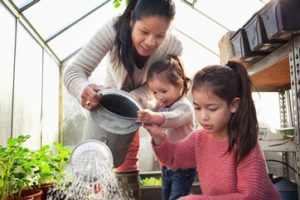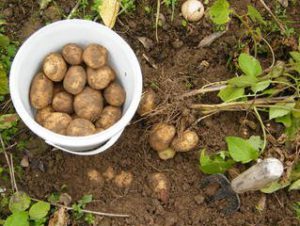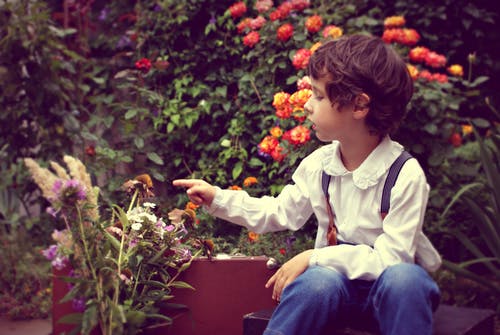Everybody with children knows when the six weeks of summer holiday arrives, children will get easily bored with nothing to so. How do you entertain them on these long days, on weekends and on those long evenings? There is a way which could pique their interest, and that is container gardening, a hobby that can become a life passion.

Gardening is a fun activity for children as they can get their hands dirty, doing something which is not only educational but providing skills that are useful for the child’s benefit in later life. They can learn maths in how to measure planting depths and distances, and in learning to count seeds.
Children will also learn science, as gardening can be seen as one large scientific experiment, as they will not know what will work and what will not. They will understand how plants will grow, where soils they will like and what the best growing conditions will be. Container gardening will get them curious in nature and how nature can benefit them in return.
WHY CONTAINER GARDENING INSTEAD OF NORMAL GARDENING?
Container gardening offers the following advantages which cannot be readily obtained in a normal garden:
- You can do it inside, as an activity even in bad weather.
- You do not need a large space in order to do it. A small patio area or yard will be sufficient.
- Little materials are required. All you need are a pot, some compost, and some seeds.
- You can do it individually, part of a school lesson or as a gardening club. Some children are naturally shy and gardening may bring them out, especially in a group setting.

Get the child Curious
- If the children do it as part of a school project or gardening club, they will be able to take the pot or its produce home, and so to get mum and dad involved.
In this article, it will be discussed what is the best way to get children involved in gardening. It is best to start them young around 3-4 years old so that their interest can be natured.
USE QUICK SPROUTING SEEDS
Children tend to be impatient, they want everything to be done now or yesterday. It is no point growing vegetable varieties that take months to produce, or flowers that take such a long time to bloom.
GROW RADISHES
The easiest vegetables to grow in containers are radishes, as they only take around 3-7 weeks to produce their edible roots. The seeds are large, so can be handled by small hands. All you need to do is get the child to fill a pot of any size with multipurpose compost. Scatter the seeds thinly on top, cover with some more compost and they get them to wait.

In 3-4 days the seedling should emerge. You can then teach them how to thin to the required distance, getting them to use judgement and a ruler. Once 7 weeks have elapsed the child can enjoy the harvest. Do not leave too long as radishes become spicy with age, and you do not want to put them off veg for the rest of their lives.
GROW CRESS
One easy crop to grow inside is cress, and you do not need soil to even do this. All that is required is an old fruit punnet box (no drilling is required as they already have drainage holes in them). Fold a kitchen towel until it fits in the bottom of the punnet box, add water until it is damp enough, whilst not being dripping wet.

Get the child to scatter the cress seeds on top of the kitchen paper. It does not matter how thick they do it, as long are the seeds are in contact with the paper towel. The top paper towel does not need to be wet.
Get the child to fold a second kitchen towel to fit on top of the seeds and the other paper towel. This will add some darkness to the container. Do not place in direct sunlight, as the seeds need darkness to germinate. This can be accomplished by placing the punnet box in a draw, and after two days check if the seeds have sprouted.
After two days when the seeds have sprouted, you can either take off the top paper towel or move the punnet to a sunny windowsill. If the paper towel has dried you can dampen it by spraying water. Do not over water as this will cause the seeds to rot.
After 10-14 days the seedlings have reached around 5cm in height, and are ready to harvest. Get the child to snip their own by using safety scissors, then under running water to clean them. Hard boil some eggs, mix with mayonnaise and cress and then get them to try the results, It is easy as that.
CUT AND COME AGAIN LETTUCE

You can also plant cut and come again lettuce, which are often quick growing. All you need to do is fill a container with multipurpose compost, scatter the seeds and cover lightly with more compost. Water regularly and within ten weeks you will have enough leaves to make a salad. It will be healthy too.
SUNFLOWER
One flower which is easy to grow is sunflowers. If you are interested you can have a growing competition to see who can grow the tallest. All you need is a 30cm diameter container full of compost, plant some seeds to see how many will germinate.

When seeds have germinated thin to one seed per container, and get the child to look after it. Water often and then measure every week to gauge how much the flowers have grown in a week. Progress can be made as part of learning how to measure. This will get the child interested and in understanding how to plant seeds, how to prepare the compost and how to look after plants.
THE NEXT STAGE
Once the child has developed these basic skills pf planting seeds and looking after plants. It is on to the next stage of sowing more complex vegetable plants and herbs.
I would start them on basil by getting them to sow some seeds thinly on top of a 15cm container. Once the seeds have germinated and have grown up to a mature size, then the child can harvest the leaves. You can grow parsley in the same way. Basil will go well with pasta dishes and parsley will go well with fish dishes.
GROWING TOMATOES

Another plant that will grow well in containers is tomatoes. The combination of basil and tomatoes will make young mouths water. I would grow a miniature tomato that can be grown in containers such as ‘Tumbling Tom Red’ or ‘Tumbling Tom Yellow’. They not only look good but will get them involved in eating what they grow.
GROWING POTATOES
Planting first early potatoes in a potato sack (readily available in many gardening centres or shops) is also an easy way for a child to get interested in eating what they grow. If you search you can find potato grow bags with a flap on the side, which can be opened to let the child see the potatoes as they grow. You can get them to feel the potatoes and even harvest some for lunch.

To do this you will need to get the child to chit some potatoes (make sure that the seed potatoes are labelled first earlies). Save some egg carton boxes in which potatoes with their eyes up, are allowed to grow short stubby green shoots (the chits). This will take around six weeks and is done to give the potatoes a head start, so they will produce the harvest quicker.
PLANT THE POTATOES
Plant the chitted potatoes in multipurpose compost in which a potato fertilizer is added. The potatoes will need covering with a thin layer of compost so that the chits are just covered. The child can then be involved in the earthing up of the stems as they grow up, adding more potato fertilizer when the compost is added. This process needs to be repeated one more time until the compost level near reaches the top of the container. Get the child to be patient and wait for the plants to flower, and after two weeks, get them to look for the little treasures of new potatoes.
You can kill two birds with one stone, as you can get the children interested in cooking at the same time. You can boil the potatoes and add butter and homegrown parsley leaves. Tomatoes can be cooked in a similar way to makes sauces, combined with basil and make a tasty tomato dishes. In that way, fussy eater may get interests in trying new foods.
STIMULATE THEIR SENSES
As children curiosity is starting to develop through their five senses, then gardening can be used to gauge these senses. You can grow plants with different textures and shapes of leaves. Grasses in containers can be used that rustle when you walk past them; grow fragrant flower like hyacinths, skimmia, carnation, and sweet peas to get their noses twitching. The herbs and vegetables to get their mouth-watering. Remember children are drawn to brightly coloured flowers, so why not grow a bee and butterfly garden in containers
Sensory plants will also benefit children with special needs or sensory impairment. It will encourage them to go exploring in a container garden jungle.
MINI TOOLS AND CLOTHES
As the children become more proficient and as adult tools are often too cumbersome to use, then it would be a good investment if they go their own set of tools. In that way your child can have their own min-trowel, mini fork, mini rake, and a small watering can, which will promote the child’s independence. They can become responsible for looking after their own container. The tools will improve their motor skills and also their mental well-being.
As gardening can be seen as a messy, dirty job, it would be wise to set aside some clothes that they can use outdoors. Working with compost can be very messy but they will enjoy getting stuck in. It is no good dressing them in their Sunday best to end up covered in compost.
In sunny weather do not forget to slap on sun creams and a large hat to stop their delicate skin from getting sunburnt.
KEEP THEM INTERESTED
The child may become engrossed in gardening of they may become bored as young children have short attention spans. Their attention may wonder after a few minutes. It is a good idea to keep things simple and have activities that will keep them occupied.
- You can get the child to produce their own seed or plant labels.
- Get them to look for ladybirds, butterflies and other insects, both good and bad.
- Get them to hunt for snails and slugs.
- Encourage them to hold the creature in their hands to get them used to what they feel like.
- Get the child to start a picture dairy with words of how the plant was started, how it has grown the flowers or harvests it has produced.
- A pressed flower book may seem old-fashioned but it will almost certainly keep them interested in gardening.
To keep them interested by asking questions throughout the planting process. Ask them what seeds they want to plant? Where to place the container and why? How tall? What colour flower do they think it will produce? When will the crop be ready to harvest? Etc.
A good idea would be to take a picture or drawing of the plant at different stages. Potato growing in containers is a very good example for this, as they can draw pictures or take photographs of the potato plants, at the planting stage, growth stage, flowering stage and finally harvesting. You can stick the photographs and picture in a scrap book, as a good learning tool. You can finish with a picture of the child eat the potatoes. Getting the child to decorate the containers by painting them or adding features such as their favourite toy will keep their interest.
CONCLUSIONS
In this article, the best methodology of getting children into gardening, especially container gardening has been discussed. It is important to keep the child interested by asking questions, giving tasks and getting them to look after a container by themselves. If they dress as a gardener, they will act as a gardener.
As ever if you have any questions or comments you want to make, please leave them in the comment box below.
Happy Gardening with your Children.





Thanks for writing this article on getting children involved in container gardening,i must say this really sound like a good idea to get children involve in container gardening because not only that it will keep them from been bored, they can also learn the process of planting it and caring for flowering plants. I can remember when I first engage my cousin in the act. Her father thought it was a bad idea not until her father see how well she take care of there home garden through all the learnt from me
Thank you afolabi
It is always a good idea to get children involved in container gardening as it will give to them the confidence to achieve something which takes time and patience. Give a child responsibility and they will reward you with what they can do.
Kind reagards
Antonio
Aaaww… This post is so spot on! My kids are so hyper that they keep me on my toes day in day out, I wonder why I never thought of something like this.
So simple but yet very engaging, trying out different ways and seeds to plant and watch them sprout will definitely keep them busy and very much interested.
U can’t wait to try this out with them. Will really be a fun and engaging activity.
Personally I have picked up a thing or two I never knew about planting.
Cheers..
Hi Queen
Thank you for those kind words in which you have hit the nail on the head to what I wanted to achieve in this article.
It is a difficult task to keep your little ones occupied throughout those long summer holidays, evenings and the weekend. This article addresses what container gardening can do for them.
Kind Regards
Antonio
Thank you very much for this wonderful post. I agree with you totally when you say that it is important to get children engaged in activities that will build their minds, give them a great experience to talk about during summer holidays and teach them great container gardening techniques. I find this post very helpful and i will start a container garden with my kids.
Thank you for this wonderful post.
Thank You Odavid
I hope you have success with your container garden and the engagement with your children. Your words are very kind and it makes me proud of what I have written so that it gets people like you and your children in gardening.
Kind Regards
Antonio
Hi! This is a very interesting topic. So much has been said in this post. And I really appreciate your experience as regards getting children involved in container gardening.I am happy to hear from you on this matter because I have a lots of kids that i would like to involve in this eye catching article. Thanks for the eye opener
Hi Tracy
Getting children involved in any kind of gardening is difficult, but with container gardening, you do not need to have a large area of land but just curiosity on the child’s behalf. I really appreciate the kind comments and hope you have a successful growing season.
Kind regards
Antonio
Hi. What a fantastic idea anbout container gardening and getting your children involved .
I wish I had have read this article a few years ago as my children are now teenagers and spend all day in their Xbox 🙂
Especially living in the uk where it rains a lot this would have helped massively to keep them entertained indoors.
Do you have any tips on how to grow peppers in containers indoors? Do they need to be kept in a warm environment?
I found your article very well written and informative Thank you for sharing it with me
Take care
Hi Matthew
It is never to late to learn gardening skills. You may have missed out with your children but in the futur,e you may get your grandchildren involved. The skills learnt will set them up for life.
To answer the question is yes, pepper does require heat, a warm sunny windowsill will suffice. All you need to do is water when the compost is dry and feed once a week with a tomato fertiliser when the flowers start to form little fruits. The problem inside would be blossom drop, where the flowers are not being pollinated. To stop this you can use a fine painter’s brush, to pick the pollen from one flower and then transfer it to another. In this way, you would be acting as a bee would, transferring pollen from one flower to another.
Thank you for those kind words.
Antonio
You have discussed in your post about the Container Plants and Gardening .Really nowadays children can easily plant the container plant to make a garden And they can cultivate flowers and vegetables easily. This will benefit both the environment and the people. Thank you so much for sharing it information.
Thanks Wadud
Children are so easily bored and so coming up with something that will entertain them and still be of interest to them is very difficult to do. I hope this article has given to you ideas on how to keep your children entertained and not bored.
Thank you for the kind words
Antonio
Hey Antonio,
It’s really amazing! I have learned a lot by reading your educative and informative article entitled ‘Getting children involved in container gardening.’ The hobby Gardening one of the best choice I think. But the idea of Kids involved in container gardening was never thought of. In fact, they will be sound fresh physically and mentally through gardening. By this, they will be in touch with nature; senses will be flourishing and they also know about various kinds of trees and insects as well. I really enjoyed the article.
Thank you sincerely for the excellent article.
Warm wishes,
Ranao.
Thank you Ranao
I am glad you enjoyed the article as you have hit the name on the head on what I was trying to achieve with this article. If children get interested in a hobby whilst young, their mental and motor skills will develop. The passion could turn into a career.
Thank you for your kind words
Antonio